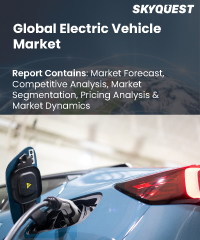
Product ID: SQMIG25C2046

Report ID:
SQMIG25C2046 |
Region:
Global |
Published Date: February, 2024
Pages:
211
|
Tables:
143 |
Figures:
83
Based on SkyQuest in-depth study, we found that Europe held the largest share of revenues in 2023 which was around 46.76%, chiefly due to factors like development of infrastructure, environmental concerns, regulatory incentives, technological advancements, and consumers changing preferences. Thereby is perennity of highly reputable and well-known electric vehicle producers in the region the main factor expanding the regional market.
In 2023, North America region has registered as one of the major contributors in the global revenue. This is due to the growth of e-vehicle sales in regional economies like the United States with other initiatives such as the automotive manufacturers, policymakers, non-profit organizations, and charging network companies focussing on doing things like the launch of a new non-profit organization named "Veloz". By so doing, the group is behind the creation of a place where investments, innovations, marketing, and growing electric.
In February 2023, the Secretary of Energy for the U.S. government announced a consideration of a substantial amount to be allocated to the research and development (R&D) of electric vehicles. It includes setting up USD 10 billion funding conundrum, USD 7.5 billion direction towards charging infrastructure, and over USD 7 billion towards EV-critical minerals, battery components, and materials. These major funding programs will work hand in hand with the Inflation Reduction Act that has presented much needed support for the advanced battery technology and now allows for a broader range of tax credits for buying electric cars and installation of charging infrastructures.
Asia Pacific is expected to outpace all other regions to emerge as a major growth driver during forecasted years. This is facilitated by the visibly growing demand to electric cars in China, Japan and India. In August 2022, the ESCAP launched the the Asia-Pacific Initiative on Electric Mobility, which aimed to speed up the transformation of the electric mobility in public transport. A move is proposed in order to decrease the transport sector’s emission of greenhouse gas and help with related Paris Agreement implementation. Japan and South Korea have been expanding their EV markets as well. Their governments have aided the increase of EV demand by providing EV charging stations, establishing pollution standards, establishing deadlines for switching from ICE cars to full or hybrid EVs, and so on.
India is likewise aiming to increase its EV market demand. The new car scrappage policy, which allows old vehicles to be scrapped in exchange for low-emission vehicles, as well as other planned laws, will help the country become the region's fastest-growing market for EVs in the next years.
Our industry expert will work with you to provide you with customized data in a short amount of time.
REQUEST FREE CUSTOMIZATIONWant to customize this report? This report can be personalized according to your needs. Our analysts and industry experts will work directly with you to understand your requirements and provide you with customized data in a short amount of time. We offer $1000 worth of FREE customization at the time of purchase.

Product ID: SQMIG25C2046